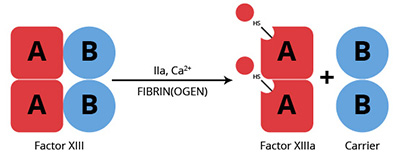Factor XIII is the zymogenic form of the glutaminyl-peptide g-glutamyl transferase factor XIIIa (fibrinoligase, plasma transglutaminase, fibrin stabilizing factor, E.C. 2.3.2.13) (1-3). Factor XIII is unique among transamidases in that it is a zymogen in vivo (2). Factor XIII is found both extracellularly in plasma and intracellularly in platelets, megakaryocytes, monocytes, placenta, uterus, liver and prostrate tissues. Plasma factor XIII is synthesized in the liver and circulates as a tetramer (Mr=320,000), composed of 2 pairs of nonidentical subunits (A2B2) (4). The intra-cellular forms are synthesized in the tissues where they reside as dimers (Mr=146,000) of 2 identical A chains (A2) (7-11). The A subunits of plasma and intracellular forms of factor XIII are functionally identical. The A subunit contains 6 free sulfhydryl groups one of which is the active site (12).
The concentration of factor XIII in plasma (A2B2) is approximately 30 mg/ml (8). It is the last of the zymogens to become activated in the coagulation cascade and it is the only enzyme in this system that is not a serine protease. The conversion of plasma factor XIII (A2B2) to the active transamidase factor XIIIa (A2′) results from hydrolysis of the Arg36-Gly37 at the NH2-terminus of the A subunit by thrombin (13). Full expression of activity is achieved only after the Ca2+ (Kd=10-3M) and fibrin(ogen) (Kd=10-8M) dependent dissociation of the B subunit dimer from the A2′ dimer (14-16).
In the coagulation cascade, factor XIIIa functions to stabilize the fibrin clot by crosslinking the a and g-chains of fibrin. Other proteins known to be substrates for Factor XIIIa which may be hemostatically important include fibronectin (17), α2-antiplasmin (18), collagen (19), factor V (20), von Willebrand Factor (19) and thrombospondin (21,22).
Factor XIII is purified from fresh frozen human plasma by a modification of the procedures described by Folke (2) and Lorand (10) involving barium citrate, ammonium sulfate and glycine precipitations, ion exchange chromatography and gel filtration. Factor XIII is homogeneous as judged by SDS PAGE, with a specific activity of ~50 units/mg. Factor XIII is supplied in 50% glycerol containing 0.5 mM EDTA, for storage at -20oC.


